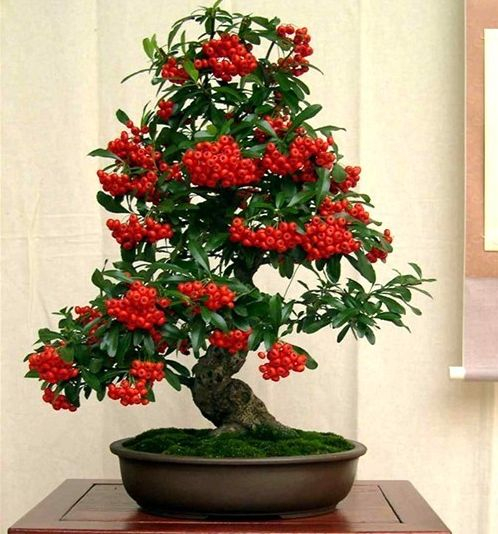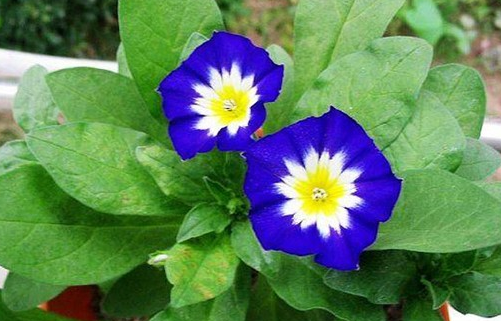Cultivation method of Pyracantha bonsai
1. Watering
The water management of Hippophae rhamnoides is very important, if the management is not good, it will affect the flowering period and fruit of Pyracantha. Watering is reduced during flowering, and the soil is dry, which is beneficial to the fruit. Pay attention to the principle that watering should follow dry watering and watering thoroughly.
two。 Sunshine
Hippophae rhamnoides likes the sunny environment, which is conducive to its blossom and fruit, and can improve the ornamental effect.

3. Temperature
The most suitable temperature for growth is 20-30 degrees Celsius. Hippophae rhamnoides is drought-resistant and can grow at minus 15 degrees Celsius. Keep the temperature below 10 degrees Celsius in winter, otherwise it is not conducive to its dormancy.
4. Soil
Hippophae rhamnoides grows fast and has many and dense roots. although it can adapt to poor soil, it prefers fertile soil with good fertility and acid sandy soil with good air permeability or rotten leaf soil plus vegetable garden soil. Usually replace 2/3 of the old soil of bonsai in a year.
5. Fertilizer application
Fire thorns like fertilizer, in spring, summer and autumn sprouting, blooming, pregnant fruit period, fertilizer and water must be guaranteed. You also need to apply fertilizer after pruning, just apply cake, fertilizer and water.
6. Insect pest
It is mainly the invasion of aphids and red spiders, which may occur in spring and autumn. It can be killed by spraying 1000 times of omethoate in 7 days, such as powdery mildew, withered leaf disease, coal fouling, etc., and can be sprayed with carbendazim solution.
How to raise fire thorn bonsai culture method
Firethorn bonsai is very popular because of its green leaves and beautiful tree shape, which can watch leaves, flowers and fruits, so it is very suitable for being placed at home. Next, I will tell you about the method of bonsai culture of firethorn.
1. Watering:
The firethorn stump in the first pot is watered at 8 o'clock in the morning and 6 o'clock in the afternoon, and all the branches are sprayed with water each time. After the new buds grow 5cm~6cm, you can water once a day, pay attention to the basin soil is not too wet, so as not to affect the normal growth of new roots. After the new buds grow out of 8cm~10cm, the new roots have been basically formed at this time. It can be seen that the basin soil is not dry or irrigated, and then poured enough until the basin bottom is running water.
two。 Fertilization:
Due to the limited space of the pot, less soil and insufficient nutrients, in order to make potted firethorn grow vigorously, it is impossible without fertilizer, but we must grasp the time and quantity of fertilization. In order to give full play to the efficiency of fertilizer and meet the needs of the growth of firethorn stump, the new pile is generally not fertilized from March to April, and 0.2% urea solution is sprayed on the basin soil and leaves every 10 days from May to June. From July to September, rapeseed cake water was applied every 10 days, from October to December, once in 15 days after being diluted with 10% chicken manure, and stopped from January to February of the following year.
With the above fertilization methods, the new branches can grow thick 1cm-1.5cm in the same year, and the shaped firethorn bonsai will also blossom and bear fruit year after year, and the fruit is many, big and bright, which can fully reflect its ornamental effect.
3. Change the basin:
Fire thorn bonsai fruit every year, the consumption of nutrients is very fast, generally large and deep pots change soil every two years, small and shallow pots need to change soil once a year. The best time to change the basin is from late February to Qingming Festival. Before the new buds germinate, remove the leaves and fruits and change the basin with nutritious soil with phosphorus and potassium fertilizer. When changing the basin, take the plant out of the basin, then use a small shovel or bamboo to remove 1/3 of the old roots and old soil around and at the bottom, and then put gauze or broken tiles on the water holes in the basin to facilitate ventilation and drainage.
Lay a layer of nutritious soil, and then put the plants into people, fill the soil on the one hand, and tamp the soil with small sticks or bamboo slices on the other. The soil must be lcm~2cm lower than the basin mouth to facilitate watering. After the change of soil, the first time the water should be fully watered, and then it will be managed normally. Do not move the firethorn bonsai that has been changed frequently, so as not to harm the growth of new roots and change the orientation of the plant, affecting the ornamental effect.
4. Pruning:
Pruning in time and promoting the hanging of fruit branches are very important for the next year. The branches of Hippophae rhamnoides grow very fast, so they should be pruned in time to promote the twigs that hang fruit. Especially in autumn, it is necessary to cut the branches in place and maintain a good tree shape, because as soon as the new branches grow in the next year, they will blossom and bear fruit. If they are not cut in autumn, the flowers of the following year will bloom on the branches at the front end, and then cut off the hanging fruit branches.
So the tree type in late autumn is basically the tree type that hangs fruit in the following year. The new branches that grow after hanging fruit on the branches can be cut off at any time to keep the crown width of the plant unchanged, and the hanging fruits are all in the outer layer of the crown width. After ripening, the ornamental effect is the best.
5. Disease prevention and pest control:
Due to environmental factors, Pyracantha is easy to get powdery mildew, harming leaves, twigs, flowers and fruits. This is due to lack of light, poor ventilation and long shading time. Spraying Bordeaux solution, stone sulfur mixture or carbendazim can be used for control. There are mainly two kinds of pests that harm the growth of firethorn: one is the piercing shell insect, which can make the stump growth decline, or even the whole plant die. The shell insect has a waxy layer, so it is difficult for drugs to enter the insect body.
Prevention and control methods:
You should observe it frequently. If you find a shell worm, you should immediately remove it with wire, stick or knife. The medicine can use 0.1% oil floating agent, spray the tree body, bury carbofuran according to 1 ‰ of the basin soil, and kill the insect through internal absorption. Second, aphids are easy to occur in spring and autumn. Aphids harm the tree stump and distort the new shoots and tender leaves, and the feces excreted by aphids fall on the leaves and fruits to form small black spots, affecting the ornamental effect of firethorn bonsai. All aphids can be killed by spraying 1000 times of omethoate or 800 times of dichlorvos twice in a row.
The above is for you to introduce the firethorn bonsai culture method, I hope it can help you, more household knowledge please pay attention.
Maintenance of firethorn bonsai
The bright red fruit of firethorn bonsai can greatly improve the ornamental quality. The following explains how to maintain the firethorn bonsai in order to help the plant increase its fruit.
(1) select plants
Firethorn bonsai is a relatively strong and healthy tender pile, which is generally easier to bear fruit, and it is also easier to prune it.
(2) soil
Firethorn bonsai does not have high requirements for soil, generally with relatively loose, fertile rotten leaf soil and pastoral soil, which has better conditions for growth.
(3) Lighting
Hippophae rhamnoides bonsai is a kind of sun-loving plant, which requires high light. Firethorn bonsai should always be cultivated in an environment with sufficient light, especially in autumn and winter, when the growth environment is not good.
(4) pruning
If the fruit is to be hung on the branches of the bonsai, stronger branches are needed to bear it, so pruning is needed to ensure that the branches thrive.
(5) fertilization
Firethorn bonsai growth process, also need to consume a certain amount of nutrition, in order to have sufficient nutrition to bear fruit, we should pay attention to give it correct fertilization. It is usually every 20-30 days in spring and 15-20 days in autumn. The type of fertilizer is mainly organic fertilizer such as phosphorus and potassium fertilizer, but it is required to be thin fertilizer.
In addition, we should also pay attention to the usual work of removing pests to avoid pot plants being damaged by the outside world.
- Prev

The main points of making firethorn bonsai
Piles are used in the south and cuttings are used in the north. 1. Pile picking: first of all, make preparations before digging, prepare branch shears, handsaws, knives, small shovels, large and small plastic bags or other packing bags. Choose the species with graceful posture, small branches and leaves, strong germination and resistance to pruning, easy potting and long life.
- Next

Culture skills of tricolor whorl
Planting environment this kind of plant is generally cultivated for one year, and most of it is creeping. Because of its appearance and habits, it is very suitable for decoration of fences or for covering slopes. In addition, fences and brackets are also good choices. If you like, you can also transplant it into a flowerpot and use it as a potted plant or flower bed decoration.
Related
- Fuxing push coffee new agricultural production and marketing class: lack of small-scale processing plants
- Jujube rice field leisure farm deep ploughing Yilan for five years to create a space for organic food and play
- Nongyu Farm-A trial of organic papaya for brave women with advanced technology
- Four points for attention in the prevention and control of diseases and insect pests of edible fungi
- How to add nutrient solution to Edible Fungi
- Is there any good way to control edible fungus mites?
- Open Inoculation Technology of Edible Fungi
- Is there any clever way to use fertilizer for edible fungus in winter?
- What agents are used to kill the pathogens of edible fungi in the mushroom shed?
- Rapid drying of Edible Fungi

